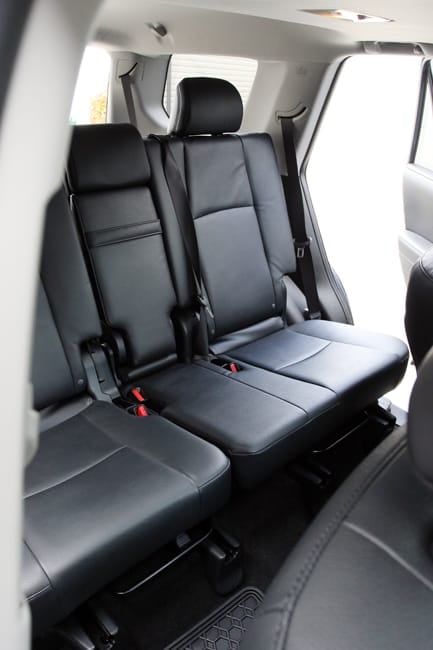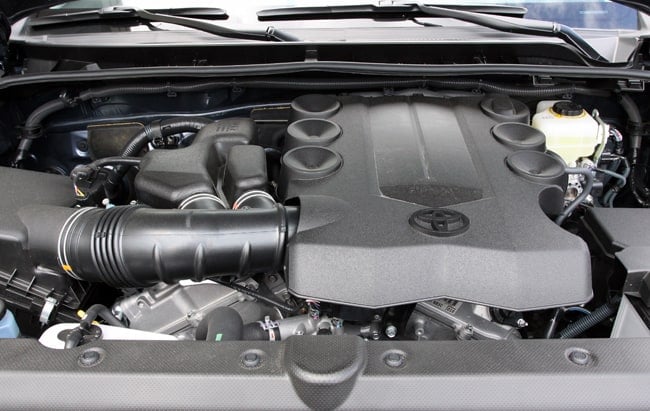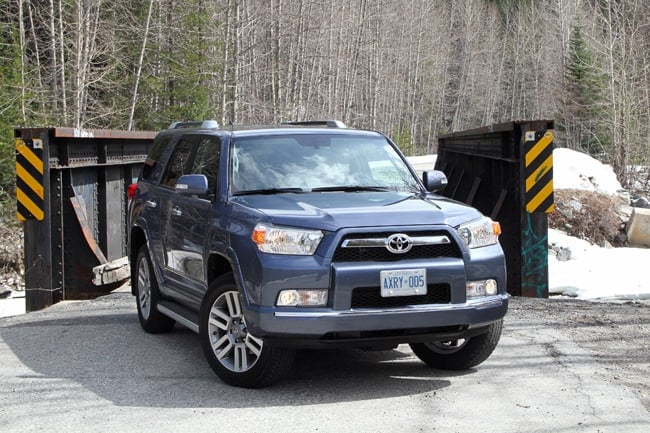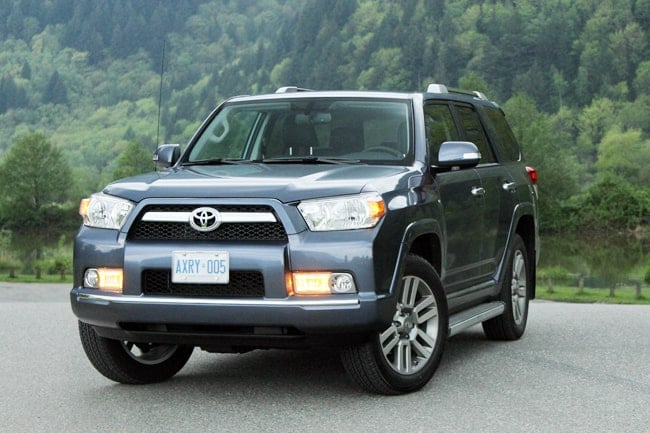There are not any significant changes for Toyota’s venerable 4Runner sport utility vehicle for 2012, but for many consumers, this will be seen as good news. I live in British Columbia, Canada, where it’s a rugged country with lots of interesting places to explore, but many of these destinations are located well off-the-beaten-path and require a vehicle with a heavy-duty frame and chassis and four-wheel-drive capabilities.
The reality is that the 4Runner is one of the few remaining SUVs available in the marketplace that is robust enough to tackle serious off-road duty, as most of its rivals have become neutered softies riding on modified passenger car frames.
4Runner styling carried over from last year

The 4Runner received its last major revision in 2010. This would be the fifth generation of the go-anywhere rig and it came sporting a more angular and boxy design than the previous model, and it also had grown in virtually every dimension. The 4Runner is far from being a small vehicle- you will be reminded of its largess every time you have to climb up and into the vehicle- but despite its substantial length, height, and width, I found it easy to park and it fit nicely into a standard garage.
The 4Runner’s styling is immediately recognizable as a Toyota, so there are styling cues and elements that you may see as familiar. I must admit that I was happy to see that there was no hood scoop on this truck, as for the last few years Toyota seemed to put these useless nostrils on all their trucks and SUVs in a misguided attempt to give them some machismo.
2012 Toyota 4Runner Interior

Cabin styling is very simple and uncluttered. The compact gauge cluster, well-organized dash layout, and tidy centre console make equipment operation a breeze. I found all the controls, switchgear, and instruments to be within easy reach and the majority of them were easy to see from the driver’s position.
The second-row seating area is roomy enough for three adults to sit comfortably, but two would be able to really stretch out for a long trip.
The front bucket seats are firm and supportive, as are those in the second row. The second-row seating area is roomy enough for three adults to sit comfortably, but two would be able to really stretch out for a long trip. The seat backs feature the ability to recline up to 16 degrees for additional comfort. Toyota only uses the highest quality materials and fit-and-finish is much better than you would expect in a SUV.

The cargo area is accessed via a swing-up hatch that I found surprisingly heavy, but it may just be that my test vehicle was a low kilometer unit and the support pistons need to break in. The hatch itself offers the user protection from the rain (or refuge from the sun) when loading or unloading, an advantage that will be appreciated when faced with the unpredictable weather conditions typical of mountainous regions.
The rear cargo area on my test vehicle featured two extra seats that stowed flat when not in use, creating a flat floor for gear, pets, and luggage. Should longer items need to be carried the second row seats fold in a 40/20/40 configuration, although they don’t quite fold flat. I came to appreciate the tie-downs and the 120 AC power outlet during my time with the truck

2012 Toyota 4Runner Horsepower and Performance
The Toyota 4Runner features the latest variant of the company’s well-sorted 4.0-litre V6 engine mated to a five-speed automatic transmission and four-wheel drive. The V6 generates a healthy 270 horsepower and 278 lb. ft of torque and is actually more powerful than the previously available V8. Toyota is working hard to improve fuel efficiency across its line-up, so the V8 option is no longer available.

| Engine | 4.0L V6 engine |
| Horsepower | 270 horsepower |
| Torque | 278 lb-ft of torque |
| Transmission | 5-speed automatic |
| Drive Type | Rear-Wheel Drive (RWD) or Four-Wheel Drive (4WD) available |
Driving impressions
I took a weekend trip into the B.C. interior to see how the power train would cope with steep hills, higher elevations, and extended highway travel. Toyota’s Super ECT Automatic Transmission features a sport Sequential Shift, which has been engineered to make towing and hill descent easier.
While the engine proved to be quite noisy at higher speeds, I did come away impressed with its acceleration and the smooth operation of its transmission. While not a sprinter, it executed stoplight launches and highway passing manoeuvres with aplomb.

The 4Runner will prove popular with your car-pool mates due to its large and comfortable cabin, but be warned that the step-in height is quite tall, and the running boards are relatively narrow. Once seated your passengers will enjoy the view offered by the tall windows and elevated seating position, but the driver may not be so enamoured with the view.
Bumpy at times due to its body-on-frame design
Unfortunately, the long hood juts out like a platform and makes it extremely difficult for the driver to judge distances when navigating tight spaces, parking, or even just monitoring the road ahead.
The 4Runner’s ride is relatively bumpy at times due to its body-on-frame design and rugged suspension (independent front; live axle rear), so if you are really looking for comfort and feel all-wheel-drive might suffice, you would be better advised to look at its sister the Highlander.
The Toyota 4Runner Limited with Navigation Package

There are three models in the 4Runner line-up for 2012 – 4Runner SR5, 4Runner Trail Edition, and 4Runner Limited with Navigation (as tested). Here’s a look at pricing at time of launch:
United States (2012 Toyota 4Runner Prices):
- Toyota 4Runner SR5: $31,090 to $38,815.
- Toyota 4Runner Trail: $35,400 to $37,405.
- Toyota 4Runner Limited: $38,595 to $43,515.
Canada (2012 Toyota 4Runner Prices):
- Toyota 4Runner SR5: $38,170 to $43,680.
- Toyota 4Runner Trail: $40,785 to $43,680.
- Toyota 4Runner Limited: $45,100 to $47,315.
The Toyota 4Runner features part-time four-wheel-drive with an automatic disconnecting differential backed up by a host of electronic nannies, including Vehicle Stability Control (VSC), Active Traction Control (A-TRAC), Hill-start Assist Control (HAC), DAC (Downhill Assist Control).
Unlike the other three 4Runner models, the 4Runner Limited with Navigation Package is equipped with a full-time four-wheel-drive system that utilizes a centre-console mounted switch, which enables the driver to quickly choose between three four-wheel-drive modes: 4WD High–Free, with engine power split between front and rear axles depending on weather and traction; 4WD High–Locked, with power split equally between front and rear axles; and 4WD–Low for slow-speed manoeuvres.
The Toyota 4Runner is truly a go-anywhere vehicle that is more than competent enough to handle daily duties as a people hauler…
During my test period with the vehicle, I didn’t get the opportunity to venture off-road, but it is common knowledge that the Toyota 4Runner has a loyal following and that many of these owners are known to take their vehicles off-road regularly.
As a result, the design team took the time to design the Trail Edition ($44,245), adding a host of equipment to help the consumer get the most out of their vehicle off-road. A kinetic suspension system, crawl control, multi-terrain ABS, and a multi-terrain select system give this model a level of prowess usually reserved for custom vehicles.
Add to this the addition of robust skid plates to protect the fuel tank and the transfer case from impact damage, and you have a true weekend warrior. Unique styling elements include a roof rack, unique grille and wheels, matte black bumpers and handles, and the aforementioned hood scoop.
The Limited model rides on 20-inch alloy wheels and features a sports suspension designed to enhance road holding. Niceties such as a dual-zone automatic climate control system, navigation, a rear backup camera, and a premium JBL-engineered entertainment system are some of the highlight features offered on this top-of-the-line model.
Takeaway: is buying a used 2012 Toyota Runner still worth it?
Pros:
- Off-road prowess is second to none
- Legendary Toyota reliability and build quality
- Loads of space for both passengers and cargo
Cons:
- Poor visibility out front for the driver
- Truck-like ride on irregular surfaces
- Intrusive wind, road, and engine noise at highway speeds
The Toyota 4Runner is truly a go-anywhere vehicle that is more than competent enough to handle daily duties as a people hauler, but should the weather or road conditions take a turn for the worse, there are few vehicles I would rather have to count on to get to my destination safe and sound.
2012 Toyota 4Runner Limited Specs and Images
- Type: 4-door, 5 or 7-passenger midsize SUV
- Layout: Front engine, four-wheel-drive
- Engine: 4.0-litre V6, DOHC, 24 valves
- Horsepower: 270 @ 5600 rpm
- Torque (lb-ft): 278 @ 4400 rpm
- Transmission: 5-speed automatic
- Brakes: Ventilated disc brakes front and rear
- Weight: 2111 kg (4655 lbs)
- Wheelbase: 2790 mm (109.8 in)
- Length: 4820 mm (189.9 in)
- Width: 1925 mm (75.8 in)
- Height: 1780 mm (70.1 in)
- Ground clearance: 243 mm (9.6 in)
- Towing capacity: 2268 kg (5000 lbs)
- Cargo capacity: 1311 L (46.3 cu.ft.) / 2540 L (89.7 cu.ft.) with seats folded
- Fuel consumption (L/100km): City: 12.6 (22 mpg) / Hwy: 9.2 (31 mpg)


